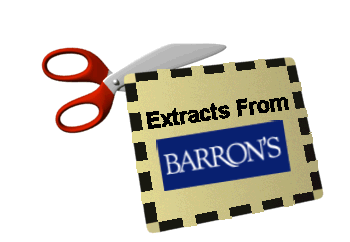
July 24, 2010
FINANCIAL RESEARCHER Lou Harvey, 68, is the founder of Boston's Dalbar, which
rates investment firms and fund companies based on customer performance and
product quality and service. Harvey recently discussed with Barron's the firm's latest
findings from its 2010 Quantitative Analysis of Investor Behavior.
Barron's:
Your studies have shown that the public usually moves in exactly the
opposite direction of smart investing. You point out that investors again missed
the boat in 2009, because they moved into safe investments like cash and missed
the upturn. Yet, as you note, the industry is sticking to methods that were
disproven in 2008. Please explain:
Harvey:
The important thing for this year's study is that it's the first time
we've been able to do a deep analysis of what happened after the 2008 market
upheaval. We've been able to look at the effect of those events on investor
behavior. What the study shows in the broadest sense is an unwillingness on the
part of the investing public to rethink investment principles. There has been no
regulatory, market or consumer pressure for change of investment protection.
Barron's:
In your study you point out that in spite of the "catastrophic" losses
in 2008 "belief in modern portfolio theory has inexplicably remained strong."
MPT is grounded in the belief that asset classes are "predictably uncorrelated."
Because MPT is no longer good for all seasons you relegate it to one of several
things investors need to consider.
Harvey:
Modern portfolio theory was pioneered by Harry Markowitz in a 1952 paper
published in the Journal of Finance. It posited the construction of an "efficient frontier" of optimal portfolios offering the maximum possible
expected return for a given level of risk. MPT is a principle-based investment
strategy whose basic idea is that better returns can be produced if a
portfolio's holdings are diversified among different asset classes. The idea: to
take advantage of the varying directions as each asset class fluctuates.
Nothing's wrong with MPT. It's how people use it. What is needed is a back-up
plan to protect investors when the theory fails. And it will most likely happen
again. We have changed so little from the 2008 failure. Risks have, if anything, increased
because of our unwillingness to face up to our problems.
The pushback to our latest report has been strong. Who are we to criticize MPT,
devised by a Nobel Prize winner? But this is our research and we stand by what
we've found. I have lots of scars on my back to prove it. And I'm sure that
after talking to you I'm going to get more. Investment results in 2008 showed
clearly that correlation of asset classes varied unpredictably and with no
warning. This brings into question the very basis for MPT and its ability to
forecast an efficient frontier. MPT simply cannot be used in isolation. Instead
it should be thought of as only one reference point for modeling the behavior of
a potential portfolio. It is only one dimension of a more comprehensive
investment-management process.
Barron's:
What's the most important finding in your recent research?
Harvey:
For me the biggest recent issue stems from the 2008 market meltdown that defied
many of the core beliefs in the financial community�the core belief that asset
classes are not correlated. When stocks go down, bonds go up. So might real
estate. By holding a little bit in each basket, the investor will make steadier
returns and avoid losses. We found out that all of the methods based on modern
portfolio theory worked within a certain range. Outside of that range, they all
failed.
Ever since the collapse, there has been a fundamental question on the table, and
that is do these practices, teachings, predating 2008 still hold true today?
Barron's:
What constitutes extreme market conditions?
Harvey:
The truth is extreme market conditions could happen anytime. Extreme market
conditions happened in May with the flash downdraft when the market suddenly
fell. But the issue goes back to 2008. What we're really saying is, don't bet
the ranch on portfolio theory; you have to have a substantial backup. Your
safety net could be cash, annuities, even U.S. Treasuries, something whose
realizable value doesn't depend on the market.
The full text of this article is available HERE. (requires paid subscription)
Copyright � 2010 Dow Jones & Company, Inc. All Rights Reserved. |

